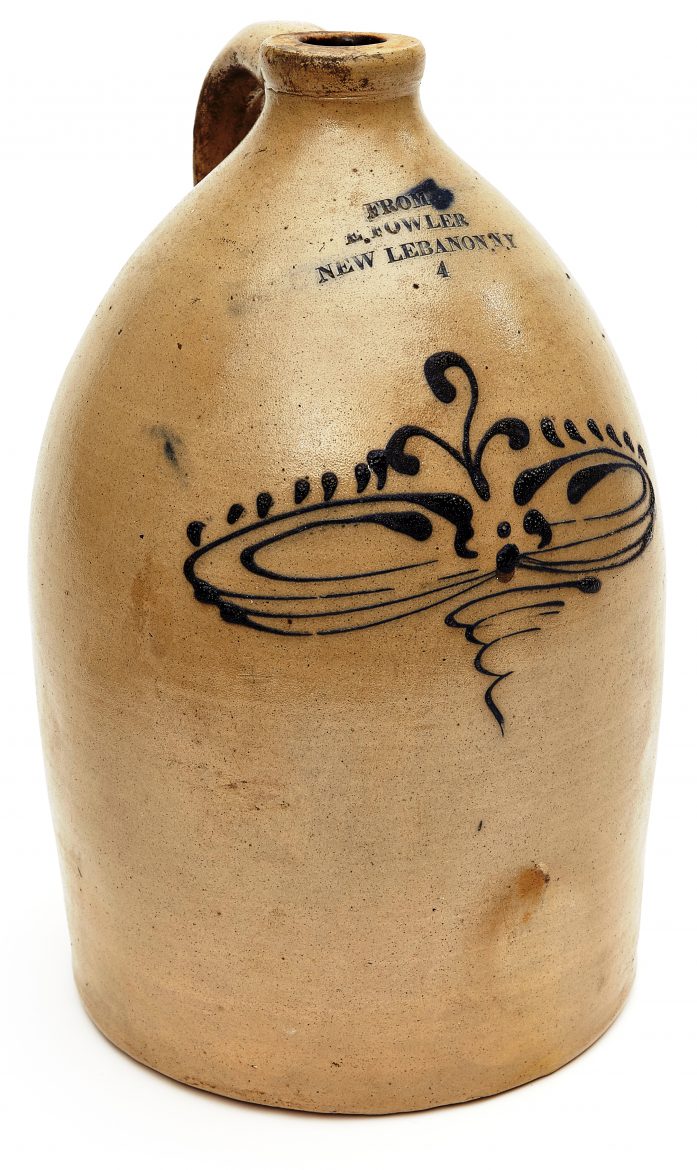
Stoneware Jug, Church and Center Family, Mount Lebanon, NY, 1853-1866/7, Shaker Museum | Mount Lebanon, 1950.653.1
It is generally accepted that the Shakers in the eastern communities purchased rather than made their crockery. With the exception of pipes – both for water and for smoking – that seems to hold true even though several communities were near ample supplies of good quality clay. Watervliet and Mount Lebanon, New York, however, were […]
It is generally accepted that the Shakers in the eastern communities purchased rather than made their crockery. With the exception of pipes – both for water and for smoking – that seems to hold true even though several communities were near ample supplies of good quality clay. Watervliet and Mount Lebanon, New York, however, were both close enough to the major pottery hubs of Albany, Troy, and Fort Edwards, New York, as well as the potteries in Bennington, Vermont, to never want for a supply of jugs, pots, jars, and pitchers.

Stoneware Jug, Church and Center Family, Mount Lebanon, NY, 1853-1866/7, Shaker Museum | Mount Lebanon, 1950.653.1
In Shaker Museum | Mount Lebanon’s collection of stoneware acquired from the Shakers at Mount Lebanon there are four pieces that lack the name of the manufacturer but in its place have been stamped, “FROM | E. FOWLER |NEW LEBANON N. Y.” Brother Edward Fowler (1800-1878) was both a Shaker Trustee and had charge of some of the Shakers’ medicinal manufacturing. One of the jugs has several labels attached to it that read, “Fluid Ext. | White-wood Bark | Lariodendron (i.e., Liriodendron),” suggesting that this particular jug was used either to store or sell extracts from the bark of the tulip poplar tree. Two of the pieces in the collection are jugs of a four gallon capacity, one is a jug that holds three gallons, and the fourth is a six-gallon pot. The decoration of the three jugs was clearly done by the same “painter,” while the decoration on the remaining pot is quite different in style. The cobalt slip glaze used in the decoration on all of these pieces is very heavily applied, to the point that on the jugs it has bubbled and on the pot it has partially chipped off. The interiors of all the jugs and the pot are glazed with a dark brown slip. This feature, known in the upper Hudson Valley as “Albany Slip” allows the suggestion that all were made in the Albany area rather than in Bennington. Further searching for the maker of these pieces was aided by the on-line catalogue of the Winterthur Museum, Garden & Library, wherein is listed a butter pot marked, “FROM | E. FOWLER |NEW LEBANON N.Y.” However, this pot also bears the stamped inscription, “ALBANY. NY |3.” This mark is associated with the Albany Stoneware Factory that operated on Hamilton Street in that city between 1853 and 1866/7. The pot in the Winterthur collection is decorated with the same design as the three jugs in the Museum’s collection.

Stoneware Pot, Church and Center Family, Mount Lebanon, NY, 1853-1866/7, Shaker Museum | Mount Lebanon, 1961.12805.1

Stoneware Pot, Church and Center Family (detail of inscription), Mount Lebanon, NY, 1853-1866/7, Shaker Museum | Mount Lebanon, 1961.12805.1
The impressed stamp found of all of these pieces was apparently applied with a tool similar to a bookbinder’s type holder in which individual pieces of lead printing type or brass debossing type can be arranged, tightly-mounted, and used to press whatever is written into clay before it is fired. On one of these pieces, the six-gallon pot with the different decoration, Edward Fowler’s last name is misspelled, “Fowlre,” suggesting that this pot was not made at the same time as the others – an observation that may explain the difference in its decoration. The Museum’s collection includes a number of jugs and pots that were made by the Albany Stoneware Factory and bear their mark, but only these four pieces are marked with Brother Edward’s name.